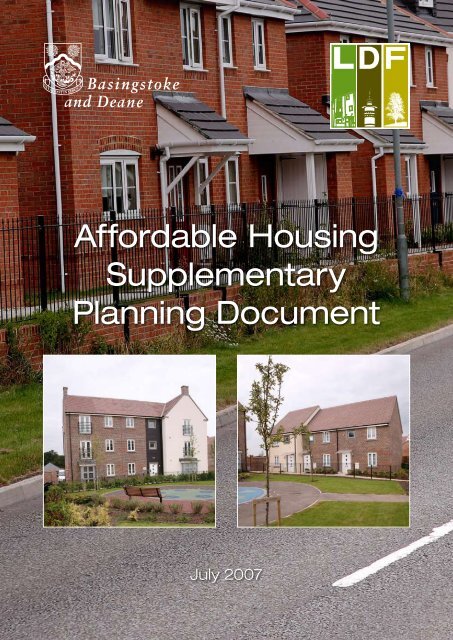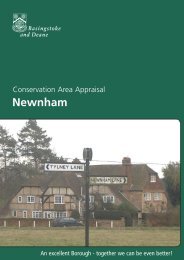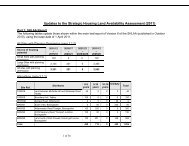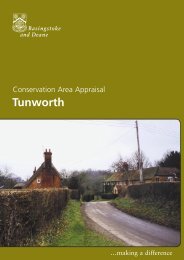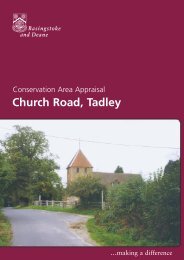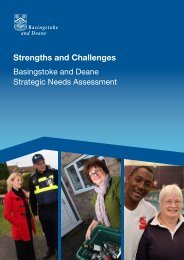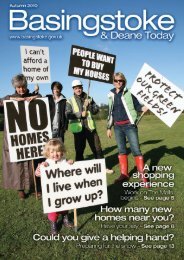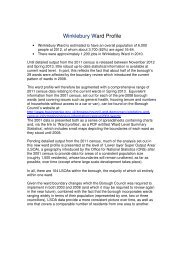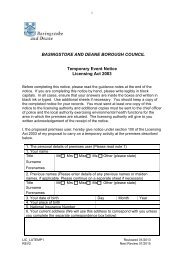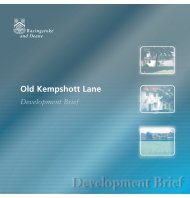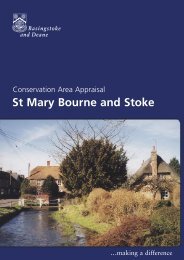Affordable Housing SPD - Basingstoke and Deane Borough Council
Affordable Housing SPD - Basingstoke and Deane Borough Council
Affordable Housing SPD - Basingstoke and Deane Borough Council
- No tags were found...
Create successful ePaper yourself
Turn your PDF publications into a flip-book with our unique Google optimized e-Paper software.
<strong>Affordable</strong> <strong>Housing</strong>SupplementaryPlanning DocumentJuly 2007
Page Supplementary Planning Document
Introduction1. Introduction 42. Preparation of <strong>SPD</strong> 43. Monitoring <strong>and</strong> Review 54. Objectives of <strong>SPD</strong> 55. Definition of <strong>Affordable</strong> <strong>Housing</strong> 76. Key Workers 97. Site-size thresholds 98. Proportion of <strong>Affordable</strong> <strong>Housing</strong> to be negotiated 109. House-size <strong>and</strong> tenure mix 1110. Specific needs 1211. Rural Exceptions 1312. Delivery – Funding <strong>and</strong> S106 Agreements 1413. Options for provision e.g. on-site/ off-site 1514. Design <strong>and</strong> Accessibility St<strong>and</strong>ards 1615. References 1616. Other Documents 17AppendicesAppendix 1 Policy Context 19Appendix 2 <strong>Housing</strong> need, Affprdabo;otu <strong>and</strong> Key Workers 22Appendix 3 Further Information <strong>and</strong> Contact Details 26Supplementary Planning Document Page
1. Introduction1.1Supplementary Planning Documents (<strong>SPD</strong>s) were introduced by the Planning<strong>and</strong> Compulsory Purchase Act 2004 as part of the reforms to the planningsystem. Although not forming part of the statutory development plan, one of thefunctions of an <strong>SPD</strong> is to provide further detail on policies <strong>and</strong> proposals within thedevelopment plan. <strong>SPD</strong>s must be consistent with national <strong>and</strong> regional planningpolicies as well as the policies set out in the development plan.1.2The <strong>SPD</strong> will be a material consideration in the determination of planningapplications. The Planning <strong>and</strong> Compulsory Purchase Act 2004 includesa requirement for all Local Development Documents to contribute to theachievement of sustainable development. Planning Policy Statement 12 ‘LocalDevelopment Frameworks’ states that local planning authorities must undertakea sustainability appraisal throughout the preparation of a Supplementary PlanningDocument. To this end a Sustainability Appraisal has been produced to informthe preparation of the <strong>SPD</strong>. The Sustainability Appraisal Report accompanies thisdocument.2. Preparation of <strong>SPD</strong>2.1This <strong>SPD</strong> has been prepared in accordance with the requirements set out inthe Local Development (Engl<strong>and</strong>) Regulations 2004. Issues <strong>and</strong> Options werepublished for public consultation in November 2005. 8 representations weremade, details of which are set out in the accompanying Public ConsultationStatement. This consultation statement also sets out the <strong>Council</strong>’s response to theissues raised.2.2As part of the preparation of the Sustainability Appraisal, a Scoping Report waspublished for public consultation in September 2005. 5 representations werereceived, details of which are set out in the accompanying consultation statement.2.3The preparation of this <strong>SPD</strong> has been undertaken in accordance with theprocedures outlined in the <strong>Council</strong>’s adopted Statement of CommunityInvolvement.Page Supplementary Planning Document
3. Monitoring <strong>and</strong> Review3.1Local Planning Authorities are required under the Planning <strong>and</strong> CompulsoryPurchase Act to prepare an Annual Monitoring Report (AMR) to assess theimplementation of the Local Development Scheme <strong>and</strong> the extent to whichpolicies <strong>and</strong> objectives in Local Development Frameworks / Local Plans are beingachieved. The <strong>Council</strong> will monitor the provision <strong>and</strong> delivery of affordable housingas part of the AMR <strong>and</strong> advise on the outcomes to Members. This <strong>SPD</strong> will bereviewed as <strong>and</strong> when necessary in light of all material information.4. Objectives of <strong>SPD</strong>4.1The <strong>Council</strong> Plan 2007-2010 seeks to meet housing need <strong>and</strong> assist those inneed of help with access to decent homes under its priorities to maintain <strong>and</strong>enhance local community well-being, <strong>and</strong> to build <strong>and</strong> sustain a strong focuson inclusion. It is therefore an important function of both the Local Plan <strong>and</strong> the<strong>Council</strong> Plan to secure the provision of affordable housing. Information on housingneed <strong>and</strong> affordability is provided at Appendix 2 to this <strong>SPD</strong>.4.2 The main objectives of this <strong>SPD</strong> are:• to clarify the policy framework for affordable housing as set out inthe adopted Local Plan 1996-2011 to enable developers, the public<strong>and</strong> other interested parties to underst<strong>and</strong> how such housing is to beprovided in the <strong>Borough</strong>;• to ensure that this framework meets the <strong>Council</strong>’s priorities of providingpeople with affordable, decent homes; <strong>and</strong>• to increase housing choice <strong>and</strong> encourage better social mix in order toreduce social exclusion.4.3The <strong>Council</strong>’s planning policies on affordable housing are set out within Policies C2<strong>and</strong> D8 of the Adopted Local Plan.Supplementary Planning Document Page
Policy C2 <strong>Affordable</strong> <strong>Housing</strong>The <strong>Council</strong> will negotiate provision of an element of affordable housing on allthe housing sites above the thresholds set out below, taking into account thecircumstances of each site (including the viability of development); the particularneed for affordable housing in that locality <strong>and</strong> in the <strong>Borough</strong>; the practicalityof delivering the affordable housing (including funding); <strong>and</strong> the achievement ofother planning objectives.The level of affordable housing provision may vary depending on the specificsof the site; however, the <strong>Council</strong>’s intending starting point for negotiations willbe 40%.• Within the settlement policy boundary of <strong>Basingstoke</strong> town, the minimumthreshold is 25 dwellings, or 1.0 hectare;• Within settlements of at least 3,000 population outside <strong>Basingstoke</strong> townarea, the minimum threshold is 15 dwellings, or 0.5 hectare;• Within settlements with fewer than 3,000 population, the minimumthreshold is 7 dwellings, or 0.2 hectare.Planning conditions will be imposed or a legal agreement sought to ensure thatthe affordable housing provided remains affordable for so long as there remainsa need for it.Policy D8 Rural ExceptionsAs an exception to the general protection of the countryside adjacent torural settlements, planning permission will be granted for development whichthe <strong>Council</strong> is satisfied will meet a genuine local need such as affordablehousing, health, education, a similar community need or to provide smallscaleemployment premises. Development proposals should complement thecharacter of the rural settlement, the character of the surrounding l<strong>and</strong>scape<strong>and</strong> not be harmful to the rural environment.The provision of affordable housing on rural exception sites will be permittedonly where the following criteria are met:iiithe housing will provide affordable accommodation <strong>and</strong> will be managedto ensure that it remains available for so long as there remains a need forit to those not otherwise able to compete in the private housing market;<strong>and</strong>the site does not exceed 0.4ha except in the larger settlements ofBaughurst, Bramley, Kingsclere, Oakley, Overton, Pamber Heath, Tadley<strong>and</strong> Whitchurch where, in general, a site should not exceed 0.8ha.Page Supplementary Planning Document
4.4The main aims of policy C2 are:• To maximise the provision of affordable housing through the planningprocess• To ensure a mix of housing on development sites• To ensure the provision of affordable housing that meets the priorityneed locally• To ensure that the affordable housing remains affordable for so long asthere remains a need for it4.5The main aims of policy D8 are:• To enable the provision of affordable housing that will meet local needsin rural areas where there would otherwise be few opportunities for thedevelopment of such housing• To ensure the provision of affordable housing that meets the priorityneed locally• To ensure that the affordable housing remains affordable for so long asthere remains a need for it4.6Policy C2 broadly seeks the provision of an element of affordable housing on allappropriate housing sites over a certain size, taking into account the viability of thedevelopment, the need for affordable housing in that locality <strong>and</strong> the practicalityof delivering affordable housing. Policy D8 makes provision for small affordablehousing developments adjacent to rural settlements as an exception to thenormal planning policies that apply to development in the countryside. This <strong>SPD</strong>document refers to the background <strong>and</strong> justification for these policies, but its mainfocus is on assisting with their implementation.4.7Information on the planning policy context for the Local Plan policies is atAppendix 1.5. Definition of <strong>Affordable</strong> <strong>Housing</strong>5.1The adopted Local Plan contains the following definition of affordable housing,based on the 2004 borough-wide <strong>Housing</strong> Needs Assessment.Supplementary Planning Document Page
‘<strong>Affordable</strong> housing is that provided, with subsidy, both for rent <strong>and</strong> low costmarket housing, for people who are unable to resolve their housing requirementsin the general housing market because of the relationship between local housingcosts <strong>and</strong> incomes. The types of affordable housing which comply with thisdefinition are:• Units for rent from a Registered Social L<strong>and</strong>lord (RSL);• Shared ownership with subsidy;• Shared equity where l<strong>and</strong> value is retained to provide housingfor sale at below market levels <strong>and</strong> where this discount can bemaintained; <strong>and</strong>• Discounted market rented housing.Subsidy includes not only public funding, but also the provision of serviced l<strong>and</strong> bydevelopers for free or at a discount.’5.2This definition is considered to be consistent with the recently published definitionin PPS3:‘<strong>Affordable</strong> housing includes social rented <strong>and</strong> intermediate housing, provided tospecified eligible households whose needs are not met by the market. <strong>Affordable</strong>housing should:• Meet the needs of eligible households including availability at acost low enough for them to afford, determined with regard tolocal incomes <strong>and</strong> local house prices.• Include provision for the home to remain at an affordable price forfuture eligible households or, if these restrictions are lifted, for thesubsidy to be recycled for alternative social housing provision’.5.3PPS3 also defines Social Rented <strong>Housing</strong> as:‘Rented housing owned <strong>and</strong> managed by local authorities <strong>and</strong> registered sociall<strong>and</strong>lords, for which guideline target rents are determined through the national rentregime. The proposals set out in the Three Year Review of Rent Restructuring(July 2004) were implemented as policy in April 2006. It may also include rentedhousing owned or managed by other persons <strong>and</strong> provided under equivalentrental arrangements to the above, as agreed with the local authority or with the<strong>Housing</strong> Corporation as a condition of grant.’Page Supplementary Planning Document
5.4Intermediate affordable housing is defined as:‘<strong>Housing</strong> at prices <strong>and</strong> rents above those of social rent, but below market price orrents, <strong>and</strong> which meet the criteria set out above. These can include shared equityproducts (e.g. Homebuy), other low cost homes for sale <strong>and</strong> intermediate rent.’6. Key Workers6.1The Glossary to the Local Plan Review contains the following definition of keyworker housing:‘Employees in essential, universally accessible public <strong>and</strong> private services, withoutwhom those services would operate at below optimal levels whose income isinsufficient to allow them to access reasonable accommodation in the privatemarket, but do not qualify to receive priority assistance through the relevanthousing legislation.’6.2Key worker housing provision may therefore form part of the affordable housingprovision (but should not reduce the amount of priority social rented housingunless there are specific site circumstances). The <strong>Council</strong> is not prescriptive in theway in which key worker housing should be provided <strong>and</strong> measures could includeshared ownership, shared equity <strong>and</strong> intermediate renting.7. Site-size thresholds7.1Policy C2 of the Local Plan requires that affordable housing is provided as part ofany development of:• 25 or more dwellings or on a site of 1 hectare or more, within<strong>Basingstoke</strong> town.• 15 dwellings or 0.5 hectares within settlements with a population of atleast 3,000 outside <strong>Basingstoke</strong> town; <strong>and</strong>• 7 dwellings or 0.2 hectares for those settlements with fewer than 3,000population.Those settlements outside <strong>Basingstoke</strong> town with a population of at least 3,000 <strong>and</strong>to which the 15 dwellings or 0.5 hectare threshold will apply are identified as:BramleyKingsclereOakleyOld BasingOvertonTadley/ Baughurst / Pamber HeathWhitchurchSupplementary Planning Document Page
7.2In considering whether a development meets the threshold for providing affordablehousing, the <strong>Council</strong> will consider the net increase in the number of dwellings onsite. Policy C2 also applies to the conversion of any building, whether or not it isalready in residential use. The <strong>Council</strong> will be mindful of any attempt to circumventthe proper operation of Policy C2, for example through the artificial sub-division ofa site.7.3Since adoption of the Local Plan, ‘PPS3: <strong>Housing</strong>’ has been published whichintroduces more flexibility in the setting of minimum site-size thresholds abovewhich affordable housing will be sought. It sets out a national indicative minimumsite-size threshold of 15 dwellings <strong>and</strong> allows Local Planning Authorities to setlower minimum thresholds, where viable <strong>and</strong> practicable, including in rural areas.On this basis, the minimum site size threshold applied to sites in <strong>Basingstoke</strong>Town will now be 15 dwellings, as per PPS3, rather than the 25 dwellings setout in the Local Plan policy. This is based on the evidence of need set out inAppendix 2. The Central Hampshire <strong>and</strong> New Forest <strong>Housing</strong> Market Assessmentwill provide an analysis of the impact on viability of market sites of alternativethresholds, with recommendations. This will be used to inform any review of thethresholds or revision of the policy (through an appropriate Development PlanDocument).8. Proportion of <strong>Affordable</strong> <strong>Housing</strong> to be negotiated8.1Local Plan Policy C2 confirms that the <strong>Council</strong> will negotiate the provision of anelement of affordable housing on all housing sites above the identified thresholdtaking into account the specific circumstances of each site. Whilst accepting thatthe level of affordable housing provision may vary depending on the individualsite, Policy C2 confirms that the <strong>Council</strong>’s starting point for negotiations willbe that 40% of the total dwellings on a site should be provided as affordablehousing. This was predominantly based on the recommendations in the latest(<strong>and</strong> previous) <strong>Housing</strong> Needs Survey update (see Appendix 2). Although it wasrecognised that this proportion of affordable housing would not provide enoughaffordable housing to meet all of the need, it is an amount that will maximisethe provision of affordable housing without inhibiting development <strong>and</strong> theachievement of other planning objectives. This target has been explored <strong>and</strong>agreed through the Local Plan process.8.2The <strong>Council</strong> will take into account the range of other planning obligations <strong>and</strong>costs associated with a particular development as part of negotiations on theproportion of affordable housing to be required. Where there are disagreementsbetween the <strong>Council</strong> <strong>and</strong> a developer on issues of viability, the developer will beexpected to provide a full financial appraisal to demonstrate their case which willbe audited by an expert, the cost of which will be borne by the developer. If adeveloper can demonstrate (through “open book accounting”) that a particular siteis not financially viable (if all the <strong>Affordable</strong> <strong>Housing</strong> <strong>and</strong> Community InfrastructurePage 10 Supplementary Planning Document
initially required by the <strong>Council</strong> is provided), then the <strong>Council</strong> may need to prioritisethe <strong>Affordable</strong> <strong>Housing</strong> <strong>and</strong> Community Infrastructure contributions sought. Itis likely that the provision of affordable housing, <strong>and</strong> in particular social rentedhousing, will remain a high priority.8.3If the <strong>Council</strong> is satisfied that the financial appraisal confirms that the affordablehousing cannot be provided in line with Policy C2, the <strong>Council</strong> will agree to analteration in the tenure split requirement in the first instance (see section 12 below)<strong>and</strong> if the proposal is still not considered viable, may subsequently agree to areduction in the overall affordable housing requirement. The <strong>Council</strong> will apply thisorder of preference until the proposal is considered viable.8.4It is expected that all affordable units provided under Policy C2 will be securedfor use by those in housing need. The control of affordable housing by a RSL willensure the proper long-term management of affordable housing. If a RSL is not tobe involved, then detailed mechanisms for the control of the affordable housing willneed to be set out in planning conditions or a legal agreement.9. House-size <strong>and</strong> tenure mix9.1The precise amount, type, size <strong>and</strong> st<strong>and</strong>ard of affordable housing will be subjectto negotiation with the developer <strong>and</strong> will be dependent upon the housing needat the time of the planning application, based on a consideration of the <strong>Housing</strong>Register, <strong>Housing</strong> Needs <strong>and</strong> Market assessments, <strong>and</strong> Rural <strong>Housing</strong> surveys.The <strong>Council</strong> encourages prospective developers to contact <strong>Housing</strong> Services atthe earliest opportunity prior to the submission of a planning application to discussthe appropriate mix for a particular site, taking into account matters such as localneed etc.9.2In terms of the tenure mix, there are various tenure arrangements that would fallwithin the definition of affordable housing. In broad terms these include:• Social Rented – properties made available to persons in housingneed usually through a RSL (such as a <strong>Housing</strong> Association) who willoffer properties at an affordable rent level, which is fixed by <strong>Housing</strong>Corporation rules.• Shared Ownership – properties administered by a RSL (or otherapproved body), which are made available on a part ownership basis.Typically, the normal starting levels are 40% or 50% ownership withthe shared owner paying an affordable mortgage <strong>and</strong> proportionate(nominal) rent payment on the remainder.• Shared equity – where l<strong>and</strong> value is retained to provide housing forsale at below market levels <strong>and</strong> where control of the ‘equity discount’Supplementary Planning Document Page 11
(normally 25% or 30%) can be retained in perpetuity by the owner/developer, Trust or a RSL.• Discounted market rented. Intermediate rent is defined by the <strong>Housing</strong>Corporation (National <strong>Affordable</strong> <strong>Housing</strong> Programme 2006-2008:Invitation to bid) as homes for rent let on assured shorthold tenancies.The rents must not be set higher than 80% of local market levels.9.3The latter three examples would fall within the term ‘intermediate housing’, asdefined in PPS3 (set out in Section 8 above). The <strong>Council</strong> will not precludeother alternative tenure arrangements providing that they meet an identified <strong>and</strong>quantified housing need, <strong>and</strong> that the benefit of the affordability can be maintainedover time9.4As identified in the <strong>Housing</strong> Needs Surveys, the priority need for affordablehousing within the <strong>Borough</strong> is for rented accommodation <strong>and</strong> the starting pointfor negotiation is that 25% of each development site should comprise affordablehousing for rent <strong>and</strong> that a further 15% should comprise shared ownership /shared equity affordable housing (‘intermediate housing’). However, the precisesplit attributed to the various different tenures will be the subject of negotiations<strong>and</strong> may vary between sites depending on the types of need prevalent in aparticular locality, the financial viability of sites (including availability of grantfunding), <strong>and</strong> site characteristics.9.5The <strong>Council</strong> has produced a <strong>Housing</strong> Mix <strong>and</strong> Lifetime Mobility St<strong>and</strong>ards<strong>SPD</strong> to provide additional guidance for developers in respect of new housingdevelopment. This applies to the private housing element of a development.10. Specific needs10.1The 2001 <strong>Housing</strong> Need Survey provided a comprehensive assessment of thelevel <strong>and</strong> nature of special housing needs across the borough. Further surveyshave also been undertaken by the <strong>Council</strong> in order to address the needs ofspecific groups such as older people, single people <strong>and</strong> key workers. The resultsof these surveys <strong>and</strong> any future surveys will be used to inform negotiations on theappropriate tenure <strong>and</strong> type of affordable housing.10.2Developers will be expected to consider the inclusion of housing to meet theneeds of specific sectors of the population on appropriate sites. This is notintended to be in addition to the requirement for general affordable housing.Page 12 Supplementary Planning Document
10.3The requirement for affordable housing extends to all types of residential (<strong>and</strong>mixed use) development, including sheltered retirement housing, subject to anidentified need.11. Rural Exceptions11.1The principle of ‘rural exception sites’ is well established as a mechanism formeeting the housing needs of local people who can no longer afford to rent or buyproperties in rural settlements. Accordingly Policy D8 of the Local Plan seeks toprovide the means whereby housing for local people can be provided where openmarket housing would not normally be allowed.11.2Outside settlement policy boundaries, residential development is strictly controlled.L<strong>and</strong> is often in agricultural use, the l<strong>and</strong> value of which is a fraction of residentiall<strong>and</strong>. The rural exceptions policy takes advantage of this lower l<strong>and</strong> value toenable the delivery of affordable homes.11.3As set out in policy D8 of the Local Plan, rural exception sites for affordablehousing should be located adjacent to the rural settlement <strong>and</strong> should be closelyrelated to the existing built up area in order to ensure that the development is notharmful to the rural environment. The style <strong>and</strong> character of such housing shouldbe in keeping with its surroundings, <strong>and</strong> particularly with local building styles. Inthe smaller rural settlements (those below 3,000 population), sites should notexceed 0.4ha; for the larger settlements (those over 3,000 population) sitesshould not exceed 0.8ha. Rural Exception sites will not be accepted adjacent to<strong>Basingstoke</strong> Town.11.4In accordance with Policy D8, rural exception sites will only be released in order tomeet an identified local need for affordable housing. This need must relate directlyto a village, parish or group of parishes <strong>and</strong> is likely to include:• People already resident in an area who are seeking separate or moresuitable accommodation; or• People who used to live in the local area <strong>and</strong> wish to return for reasonsof employment or family connections; or• People who are employed in the area but live elsewhere.11.5Evidence of local need should be submitted alongside any planning application<strong>and</strong> must be prepared in accordance with advice from the <strong>Council</strong>’s <strong>Housing</strong>Services. The target for delivery of affordable housing in rural areas as set out inthe <strong>Housing</strong> Strategy will also be taken into account.Supplementary Planning Document Page 13
11.6General market housing, or mixed developments consisting of high-value housingused to cross-subsidise affordable housing on the same site, are inappropriate onexception sites.11.7The <strong>Council</strong> will seek to ensure that adequate arrangements are in place tosecure the availability of properties for subsequent occupiers for as long as theneed exists. Both planning conditions <strong>and</strong> planning obligations may be usedfor this purpose. The inclusion of clauses in planning obligations which wouldenable lenders of private finance to dispose of property in the open market as alast resort, if a borrower were to get into financial difficulties, are unacceptable inrespect of housing schemes on exception sites.11.8The Hampshire Alliance for Rural <strong>Affordable</strong> <strong>Housing</strong> (HARAH) has beenestablished to take a strategic view on the funding <strong>and</strong> provision of rural exceptionsites.12. Delivery – Funding <strong>and</strong> S106 Agreements12.1The <strong>Council</strong> has published Interim Planning Guidance on Section 106 PlanningObligations <strong>and</strong> Community Infrastructure (adopted July 2005, revised November2006). This provides additional information on the legal <strong>and</strong> policy basis fornegotiating planning obligations in respect of policy C1, <strong>and</strong> provides the localcontext for the provision of facilities, community infrastructure <strong>and</strong> affordablehousing through development proposals.12.2The presumption is that affordable housing, where provided, will primarily be forrent <strong>and</strong> should form part of the development proposal, including the provision ofserviced l<strong>and</strong> at no extra cost. In the absence of Social <strong>Housing</strong> Grant from the<strong>Housing</strong> Corporation, the <strong>Council</strong> would expect developers to not only providel<strong>and</strong> for affordable housing, but also to provide sufficient funding to <strong>Housing</strong>Associations / RSLs to ‘bridge the gap’ between:• The cost of delivering affordable housing on the site concerned;less• The amount of finance that the <strong>Housing</strong> Association/RSL canreasonably raise (via loans/charge/mortgage etc) in respect of theparticular affordable housing development.12.3The <strong>Council</strong> recognises the need for, <strong>and</strong> welcomes, early negotiations withprospective developers <strong>and</strong> RSLs on the most appropriate delivery mechanismsfor affordable housing on any specific site.Page 14 Supplementary Planning Document
12.4The <strong>Council</strong> will adopt the following approach in order of priority (the ‘cascade’approach):• Secure the provision of l<strong>and</strong> <strong>and</strong> affordable housing, mainly for socialrent, without the need for public subsidy;• Secure a financial contribution towards the cost of providing theaffordable housing (mainly for social rent), in addition to securingthe transfer of the l<strong>and</strong> required to a housing association [or otherapproved affordable housing provider]. This would have the affect ofreducing the public subsidy required per unit, with the hope that thiswould make the scheme more attractive to the <strong>Housing</strong> Corporation inthe event that grant funding is forthcoming;• Secure the transfer of free l<strong>and</strong> to a housing association [or otherapproved affordable housing provider]. This would require a grant fromthe <strong>Housing</strong> Corporation, or funding from a different source, in order toenable the provision of affordable housing to proceed.• In the event that there is still a shortfall in funding, the <strong>Council</strong> willconsider an alternative type <strong>and</strong> mix for the affordable housing.12.5The <strong>Council</strong> has also produced a Best Practice note on <strong>Affordable</strong> <strong>Housing</strong> <strong>and</strong>Community Infrastructure (www.basingstoke.gov.uk/council/legal/notes/_default.htm). This provides an overview of what the <strong>Council</strong> seeks to achieve <strong>and</strong> itsprocedures for the planning application <strong>and</strong> S106 Agreement process relatingto affordable housing <strong>and</strong> community infrastructure. It is intended to helpdevelopers, <strong>Housing</strong> Associations/Registered Social L<strong>and</strong>lords <strong>and</strong> <strong>Council</strong>officers through the process. The document also includes specimen S106Agreements for detailed <strong>and</strong> outline consents, which will form the basis for allS106 Agreements, <strong>and</strong> speed up the legal process <strong>and</strong> delivery on the ground.13. Options for provision e.g. on-site/ off-site13.1The <strong>Council</strong> considers that where a requirement for affordable housing isconsidered appropriate, it should be provided on-site as part of the development.However, there may be exceptional circumstances that would justify a financialor other contribution towards the provision of the required element of affordablehousing on another site in the <strong>Borough</strong>. Any off-site provision should be located inclose proximity to the parent application so that it contributes to the housing needof that particular area <strong>and</strong> helps create mixed <strong>and</strong> balanced communities.13.2Commuted sums will be calculated on the basis of l<strong>and</strong> values (<strong>and</strong> constructioncosts) of the required affordable housing tenure in the local area <strong>and</strong> will onlybe accepted where the developer can demonstrate exceptional reasons for notproviding the affordable housing on site, <strong>and</strong> that there is local availability ofSupplementary Planning Document Page 15
purchasable l<strong>and</strong> for the off-site provision. The <strong>Council</strong> must be satisfied thatsuch arrangements would actually result in the provision of affordable housing thatwould not otherwise be provided in the area.14. Design <strong>and</strong> Accessibility St<strong>and</strong>ards14.1The <strong>Council</strong> will seek to ensure that issues of design <strong>and</strong> accessibility are takeninto account in the provision of affordable housing.14.2In order to ensure developments contribute to the creation of balanced <strong>and</strong> mixedcommunities, affordable housing on new developments should be fully integratedwithin the open market housing. The <strong>Council</strong> therefore expects the affordablehousing to be ‘pepper potted’ in small groups throughout a development <strong>and</strong> tobe indistinguishable in design terms from open market housing.14.3In order to ensure that rented properties are sustainable in the long term, <strong>and</strong>to ensure the development qualifies for any grant funding which might becomeavailable, all affordable housing should conform to the latest <strong>Housing</strong> CorporationSt<strong>and</strong>ards.14.4The <strong>Council</strong> will encourage developers <strong>and</strong> RSLs to provide affordable housingthat meets the highest viable EcoHomes st<strong>and</strong>ards. Four ratings can be achievedfrom Pass, Good, Very Good <strong>and</strong> Excellent. All new developments fundedthrough the <strong>Housing</strong> Corporation’s National <strong>Affordable</strong> <strong>Housing</strong> Programme 2006-08 are required to achieve an EcoHomes ‘Pass’ rating. <strong>Housing</strong> Associationsmust achieve an EcoHomes ‘Very Good’ rating (to get grant funding). The<strong>Housing</strong> Corporation have recently announced that in the forthcoming bid round(2008-2010) EcoHomes will be replaced with the Code for Sustainable Homes asthe energy/sustainability measure (this will be at a level of the Code that is roughlycomparable with the EcoHomes ‘very good’ st<strong>and</strong>ard). The Code measuresthe sustainability of a home against design categories rating the whole home asa complete package within one of six levels with level 6 being zero-carbon. Itintroduces minimum st<strong>and</strong>ards for energy <strong>and</strong> water efficiency requiring higherlevels of sustainability. It also includes areas of sustainable design such as Lifetimehomes <strong>and</strong> the inclusion of composting facilities. The <strong>Council</strong> is currently draftinga Design <strong>and</strong> Sustainability Supplementary Planning Document.14.5Developers must comply with the <strong>Council</strong>’s adopted Statement of CommunityInvolvement when making an application.15. ReferencesDCLG/ODPM/DETR/DTLR PublicationsCircular 05/2005: Planning Obligations (July 2005)Page 16 Supplementary Planning Document
PPS3: <strong>Housing</strong> (November 2006) including Delivering <strong>Affordable</strong> <strong>Housing</strong>http://www.communities.gov.ukGovernment Office for the South EastRegional Planning Guidance for the South East: RPG9 (March 2001)http://www.go-se.gov.ukSouth East Engl<strong>and</strong> Regional AssemblyThe South East Plan (March 2006)http://www.southeast-ra.gov.uk/southeastplan/Hampshire County <strong>Council</strong>Hampshire County Structure Plan (adopted January 2000)http://www.hants.gov.uk/structureplan/<strong>Basingstoke</strong> <strong>and</strong> <strong>Deane</strong> <strong>Borough</strong> <strong>Council</strong>The <strong>Council</strong> Plan 2006-2009Draft <strong>Council</strong> Plan 2007-2010<strong>Basingstoke</strong> <strong>and</strong> <strong>Deane</strong> <strong>Borough</strong> Local Plan 1996-2011 (adopted July 2006)Best Practice Note: <strong>Affordable</strong> <strong>Housing</strong> <strong>and</strong> Community Infrastructure (Summer2006)Interim Planning Guidance on Section 106 Planning Obligations <strong>and</strong> CommunityInfrastructure (November 2006)Annual Monitoring Report 2004/05<strong>Housing</strong> Strategy 2004-2007Draft Statement of Community Involvement (May 2006)<strong>Housing</strong> Mix <strong>and</strong> Lifetime Mobility St<strong>and</strong>ards <strong>SPD</strong> (Issues <strong>and</strong> Options Paper)http://www.basingstoke.gov.uk16. Other Documents<strong>Housing</strong> Needs Assessment, (2001) David Couttie Associates<strong>Housing</strong> Needs Update Survey (2005) David Couttie Associateshttp://www.basingstoke.gov.ukSupplementary Planning Document Page 17
Key Worker Survey, Portsmouth Business School (2001)Weatheralls Key Worker Study (2001)Weatheralls Key Worker Study Update (2003)Rural <strong>Housing</strong> Needs Survey Report Executive Summary (Community ActionHampshire, 2003)Single Persons <strong>Housing</strong> Survey (David Couttie Associates, 2000)<strong>Housing</strong> Survey of Ethnic Minorities in <strong>Basingstoke</strong> (2006)Pride in our Place: The Community Strategy for <strong>Basingstoke</strong> <strong>and</strong> <strong>Deane</strong> 2006-2016http://www.basingstokelsp.org<strong>Housing</strong> Corporation Scheme Development St<strong>and</strong>ardshttp://www.housingcorp.gov.ukEcoHomes 2006 The Environmental Rating for Homes (April 2006)http://www.breeam.org/pdf/EcoHomes2006Guidance_v1_2_April2006.pdfHampshire Alliance For Rural <strong>Affordable</strong> <strong>Housing</strong> (HARAH) - Hyde <strong>Housing</strong>Associationwww.hyde-housing.co.ukPage 18 Supplementary Planning Document
Appendix 1Policy Context1. Government GuidancePlanning Policy Statement 31.1Planning Policy Statement 3: <strong>Housing</strong> was published in December 2006 <strong>and</strong>replaces both PPG3 <strong>and</strong> Circular 6/98. One of the key objectives outlined by theGovernment in PPS3 is to deliver a better balance between housing dem<strong>and</strong> <strong>and</strong>supply in every housing market <strong>and</strong> to improve affordability where necessary. Itdefines affordable housing as including social-rented <strong>and</strong> intermediate housing,but specifically excludes low cost market housing.1.2PPS3 has introduced a national indicative minimum site-size threshold of 15dwellings. It also introduces more flexibility in the setting of minimum site-sizethresholds above which affordable housing will be sought. Local PlanningAuthorities may depart from the indicative minimum threshold of 15 dwellingswhere it can be justified, taking into account the level of affordable housing tobe sought, site viability, the impact on the delivery of housing provision <strong>and</strong> theobjective of creating mixed <strong>and</strong> sustainable communities.1.3PPS3 also includes a rural exception site policy to enable local planningauthorities to allocate or release small sites within <strong>and</strong> adjoining existing smallrural communities which may be subject to policies of restraint <strong>and</strong> would not bereleased for market housing. It confirms that rural exception sites should only bereleased for affordable housing secured as such in perpetuity.1.4The government have also produced accompanying guidance on ‘Delivering<strong>Affordable</strong> <strong>Housing</strong>’ which outlines the policy challenges <strong>and</strong> delivery mechanismsavailable. An additional note on identifying sub-regional housing market areas isdue to be published.2. Regional Planning Guidance (RPG 9) for theSouth-East of Engl<strong>and</strong>2.1RPG9 recognises the strong dem<strong>and</strong> for affordable housing in the South East.It also highlights the current household projections, which indicate the growingproportions of one <strong>and</strong> two person households. Policy H4 requires the provisionof a range of dwelling types <strong>and</strong> sizes, including affordable housing, to meet locallyassessed need.Supplementary Planning Document Page 19
The Draft South East Plan (March 2006)2.2The draft South East Plan notes that rates of new affordable housing provision inthe region have been running well below the rate required to meet existing needs.Policy H4 requires Local Development Documents to set targets for the provisionof affordable housing, taking account of the results of housing need <strong>and</strong> marketassessments, <strong>and</strong> having regard to the overall regional target that 25% of all newhousing should be social rented accommodation <strong>and</strong> 10% other forms of affordablehousing. It is expected that the South East Plan will be adopted in 2008.Regional <strong>Housing</strong> Strategy (2006)2.3The Regional <strong>Housing</strong> Strategy highlights the housing priorities for the region’s twoyear budget. These include increased provision of new affordable housing <strong>and</strong>upgrading of existing stock, prioritising of social rented accommodation, support forkey workers <strong>and</strong> support for the principle of meeting housing needs across a subregionalhousing market area.3. Hampshire County Structure Plan 1996-2011 (Review)3.1The Structure Plan identifies that affordability of housing is a major issue acrossthe County with many people unable to afford house prices or rents on the openmarket. Policy H7 of the Structure Plan seeks to make provision to meet thedifferent needs of the community in terms of the size, cost <strong>and</strong> tenure of newhousing. Policy H8 requires that, where there is an identified need, local planningauthorities negotiate for a proportion of affordable housing to be provided on sites,having regard to the overall need for such housing, the local housing market <strong>and</strong> thesuitability of the site. Policy H9 allows for small-scale housing developments withinor adjacent to rural settlements where there is an identified local need. However,the Structure Plan will not be saved after September 2007 although some policiesmay be saved until the South East Plan is adopted.4. Community Strategy4.1Under the Local Government Act 2000, all District <strong>and</strong> County authorities have aduty to prepare community strategies. Local Development Documents, such as this<strong>SPD</strong>, should express those elements of the community strategy that relate to thedevelopment <strong>and</strong> use of l<strong>and</strong>. The Community Strategy for <strong>Basingstoke</strong> <strong>and</strong> <strong>Deane</strong>‘Pride in our Place’ has been prepared by the Local Strategic Partnership <strong>and</strong>sets out a medium to long-term vision for the <strong>Borough</strong>. Access to <strong>and</strong> provision ofaffordable housing is identified as a key priority.Page 20 Supplementary Planning Document
5. <strong>Housing</strong> Strategy5.1The <strong>Council</strong>’s <strong>Housing</strong> Strategy 2004-2007 (adopted July 2004) sets out the<strong>Council</strong>’s current <strong>and</strong> future objectives, priorities <strong>and</strong> actions for housing. TheStrategy identifies four priorities for the <strong>Borough</strong>:• Increasing the supply of social rented accommodation• Increasing the supply of affordable housing for ownership or partownership• Addressing homelessness in the <strong>Borough</strong>• Physical <strong>and</strong> social improvement of the <strong>Borough</strong>5.2The issues associated with the first two priorities in particular show thecontribution of the planning system in meeting these priorities, <strong>and</strong> policy C2of the Local Plan is particularly relevant. The <strong>Housing</strong> Strategy will be reviewedfollowing the outcome of a <strong>Housing</strong> Market Assessment which is due to beconcluded in October 2007.Supplementary Planning Document Page 21
Appendix 2<strong>Housing</strong> Need, Affordability <strong>and</strong> Key Workers1. <strong>Housing</strong> Needs Assessment1.1 In 2001, David Couttie Associates (DCA) carried out a <strong>Borough</strong>-wide <strong>Housing</strong>Needs Assessment, <strong>and</strong> desktop updates have been carried out in 2003,2004 <strong>and</strong> 2005. The original report concluded that about 1,070 affordabledwellings would be required up to 2006 in order to house everyone on the<strong>Council</strong>’s <strong>Housing</strong> Need Register in 2001, together with all households in needof subsidised affordable housing projected to emerge over the subsequentfive years. This level of development exceeded the overall rate of housingcompletions of all types <strong>and</strong> tenures projected in the <strong>Borough</strong> for the sameperiod. It was recognised that this was not economically deliverable, nor wouldit meet the Government objective of creating mixed <strong>and</strong> inclusive communitiesto meet the existing <strong>and</strong> projected affordable housing needs in their entiretywithin market housing developments. Nevertheless, the <strong>Housing</strong> NeedsUpdates have consistently demonstrated a substantial need for affordablehousing which considerably exceeds any realistic expectation of being fullymet.1.2 In 2005, DCA carried out an update to the <strong>Housing</strong> Needs Assessment. Thereport concludes that access to market housing has become more difficultfor new households than it was in 2004. This is as a result of house priceincreases above wage inflation, increasing the need for subsidised housingespecially in the higher priced rural areas. The total affordable housing needannually is now 1,238 units. Net re-lets of the existing social stock after theRight to Buy impact average 522 units, based on the average of recent years(2002/03 – 2004/05). Even after allowing for this level of supply, there will stillbe an annual affordable housing shortfall of 708 units a year. The <strong>Housing</strong>Needs Assessments therefore highlight the need to maximise the provision ofaffordable housing through the planning system.1.3 A <strong>Housing</strong> Market Assessment is currently being progressed for CentralHampshire <strong>and</strong> the New Forest (including the <strong>Basingstoke</strong> <strong>and</strong> <strong>Deane</strong> <strong>Borough</strong><strong>Council</strong> area). The final report is due in late summer 07. This will help set thestrategic context for shaping the housing market(s) within the area <strong>and</strong> willinform the development of future local housing strategies <strong>and</strong> planning policies.2. Rural <strong>Housing</strong> Needs Survey2.1 The <strong>Council</strong> is working with Community Action Hampshire to facilitate ruralhousing development in the rural area. A sub-regional rural housing strategy isbeing discussed within the partnership. A borough-wide Rural <strong>Housing</strong> NeedSurvey was undertaken in 2003 which found that 18% of the rural populationconsidered themselves to be in housing need <strong>and</strong> that 86% of that need is forsingle adults <strong>and</strong> couples without children.Page 22 Supplementary Planning Document
3. <strong>Housing</strong> Register3.1The <strong>Housing</strong> Register is the focal point for all applicants <strong>and</strong> existing socialhousing tenants who seek re-housing. It facilitates the process of prioritising <strong>and</strong>selecting applicants for long-term social housing tenancies on the basis of housingneed. It also provides an excellent mechanism for assessing <strong>and</strong> gauging levelsof housing need <strong>and</strong> actual dem<strong>and</strong> for accommodation throughout the <strong>Borough</strong>,particularly at a micro level within specific localities.Table 1: Numbers on <strong>Housing</strong> RegisterTotal on <strong>Housing</strong>RegisterNumbers inNeed (excludingtransfers)% of Total Registerin Need2002 4281 2512 592003 4497 2743 612004 4764 3010 632005 4937 3262 662006 5058 3454 68Source: <strong>Housing</strong> Services, <strong>Basingstoke</strong> <strong>and</strong> <strong>Deane</strong> <strong>Borough</strong> <strong>Council</strong>3.2Analysis of the <strong>Housing</strong> Register shows that the dem<strong>and</strong> for affordable rentedaccommodation is increasing year on year despite the build programme deliveringover 200 new dwellings per year. As a result, there is an increased need fortemporary homeless accommodation because new houses are not being providedquickly enough. Whilst there are those on the <strong>Housing</strong> Register who would preferhome ownership, the majority would not be in a position to purchase, even at asignificantly reduced market price. On this basis, the priority for affordable housingprovision continues to be rented accommodation provided by registered sociall<strong>and</strong>lords, as this is the type of housing that most appropriately responds to localneed.4. Affordability4.1In defining housing requirements, the <strong>Housing</strong> Needs Assessment (HNA) hastaken into account dem<strong>and</strong>, need <strong>and</strong> preferences. Households that can enterthe general market without intervention of any sort can be defined as dem<strong>and</strong>,whereas those households unable to enter the general market without some formof intervention can be defined as having a housing need. Preferences take intoaccount the costs of buying in the <strong>Borough</strong> but also reflect the impact of changingemployment patterns <strong>and</strong> lifestyle changes in tenure choices. Affordabilityis defined by the relationship between local incomes <strong>and</strong> the local generalhousing market. Therefore, the ability of a household to satisfy its own housingSupplementary Planning Document Page 23
equirement is fundamentally a factor of the relationship between local houseprices <strong>and</strong> households income.5. Purchase Income Thresholds5.1More importantly, the distribution of earnings (ASHE 2005) showed that 10% ofthe County earned less than £13,084, 25% earned less than £17,573, <strong>and</strong> 50%earned less than £25,000.5.2The 2005 update to the <strong>Housing</strong> Needs Survey confirmed that the income neededto enter the housing market in the main settlements in the <strong>Borough</strong> ranged from£28,500 to £58,400 (Table 3.1 <strong>Housing</strong> Needs Survey Update - 2005). Thesefigures are derived from an assessment of the cheapest entry-level prices of thesmallest units <strong>and</strong> are based on 95% mortgage availability <strong>and</strong> a 3x gross incometo lending ratio (although it is acknowledged that some lenders are now offeringhigher ratios than this, the 3x income lending ratio is still seen as the norm,providing a realistic level of repayments with some allowance for fluctuations ininterest rates).5.3The 2005 update provides information on ‘concealed households’, whichillustrates a particular example of the housing need (it is also useful to look atan example of purchase/rental income thresholds for households rather thanindividuals). Concealed households represent, in the main, young people whoare about to leave the parental home to set up a home of their own. The surveyshows that 70.6% of concealed households have an income of less than £22,120.This means that 83.5% of concealed households would be unable to buy a onebed flat in the cheapest area of the <strong>Borough</strong> <strong>and</strong> 96.7% of concealed householdswould be unable to afford a two bed terraced property in the most expensive areaof the <strong>Borough</strong> (Table 3.6 <strong>Housing</strong> Needs Survey Update – 2005).5.4Overall, average house prices in the <strong>Borough</strong> have grown from 5.1 times averageearnings in 1998 to nearly 7.3 times in 2005. For those who do not earn theirown homes, the situation is worsening more rapidly than these figures imply.Focussing on the lower quartile house prices (approximately £150,000 in 2005)<strong>and</strong> median earnings (which provide a better indication of middle ranking income),the relationship has grown from 3.3 times to 5.7 times over the same period.5.5It is apparent that high house prices have had a major impact on households’ability to access the local housing market. Given that 50% of the populationof Hampshire earn less than £25,000, it is clear that even entry level housingis beyond the reach of a high proportion of earners (even taking into accountthe salaries of two people on low incomes wishing to share the purchase of aproperty). This indicates that low-cost market housing, without subsidy, would notmeet the needs of those on the housing register on lower incomes.Page 24 Supplementary Planning Document
6. Rental Income Thresholds6.1Rental income thresholds were also calculated as part of the 2005 update. Thisconfirmed that the income levels needed to enter the private rented market inthe <strong>Borough</strong> ranged from £25,200 for a one bed flat to £33,600 for a two bedterraced property. These figures are based on an assessment of the cheapestrental prices of the smallest units based on rent at 25% of gross income(equivalent to 30% of net income) (Table 3.3 <strong>Housing</strong> Needs Survey Update- 2005). Again, given the average income, <strong>and</strong> distribution of earnings in theCounty, the private rental market will still not be accessible to those on lower, <strong>and</strong>indeed average, incomes.6.2As an example, the <strong>Housing</strong> Needs 2005 update confirms that 74.5% ofconcealed households would be unable to rent a one bed flat in the cheapest areaof the <strong>Borough</strong> <strong>and</strong> 89.5% would be unable to rent a two bed terrace in the mostexpensive area of the <strong>Borough</strong> (Table 3.7 <strong>Housing</strong> Needs Survey Update -2005).These surveys consistently show the need for more social rented housing <strong>and</strong>discounted market rented housing to provide for those who cannot afford to rentprivately.6. Key Workers6.1Atis Real Weatheralls undertook a Key Worker <strong>Housing</strong> Needs Survey of the<strong>Borough</strong> in 2003. The study was prepared on the basis that housing need occurswhen a key worker’s income is insufficient to allow them to access reasonableaccommodation in the private market, or their income <strong>and</strong> circumstances aresuch that they cannot receive priority assistance through the relevant housinglegislation. Based on this research, the total number of key workers in housingneed was estimated to be in the range of 177 to 412 households a year. Keyworker housing is therefore considered to be one element of the wider housingneed.Supplementary Planning Document Page 25
Appendix 3Further Information <strong>and</strong> Contact DetailsForward PlanningAnne Shattock, tel: (01256) 845464,e-mail: anne.shattock@basingstoke.gov.uk<strong>Housing</strong>Michael Shepherd, tel: 01256) 845759,e-mail: michael.shepherd@basingstoke.gov.ukLegal ServicesLisa Batchelor, tel: (01256) 845345,e-mail: lisa.batchelor@basingstoke.gov.ukDevelopment ControlGiorgio Framalicco, tel: (01256) 845440,e-mail: giorgio.framalicco@basingstoke.gov.ukPage 26 Supplementary Planning Document
Supplementary Planning Document Page 27
This <strong>Basingstoke</strong> <strong>and</strong> <strong>Deane</strong> <strong>Borough</strong> <strong>Council</strong> Supplementary PlanningDocument is available from:The <strong>Basingstoke</strong> <strong>and</strong> <strong>Deane</strong> <strong>Borough</strong> <strong>Council</strong>’s website:www.basingstoke.gov.uk/planning/localplan/spd.htm& The Civic Offices <strong>and</strong> all Libraries in the <strong>Borough</strong>For a hard copy of the document, or for additional information on the <strong>Affordable</strong> <strong>Housing</strong> Supplementary PlanningDocument, please contact:Forward Planning <strong>and</strong> Transport Team<strong>Basingstoke</strong> <strong>and</strong> <strong>Deane</strong> <strong>Borough</strong> <strong>Council</strong>Civic Offices, London Road<strong>Basingstoke</strong>,RG21 4AHTelephone: 01256 845464E-mail: anne.shattock@basingstoke.gov.ukIf you would like further information about this document, or any aspect of the emerging <strong>Basingstoke</strong> <strong>and</strong> <strong>Deane</strong>Local Development Framework (LDF) please contact us. If you wish, your details will be added to our LDFconsultation database, <strong>and</strong> you will be kept informed about Local Development Documents as they are produced.12524 - 0907Page 28 Supplementary Planning Document


